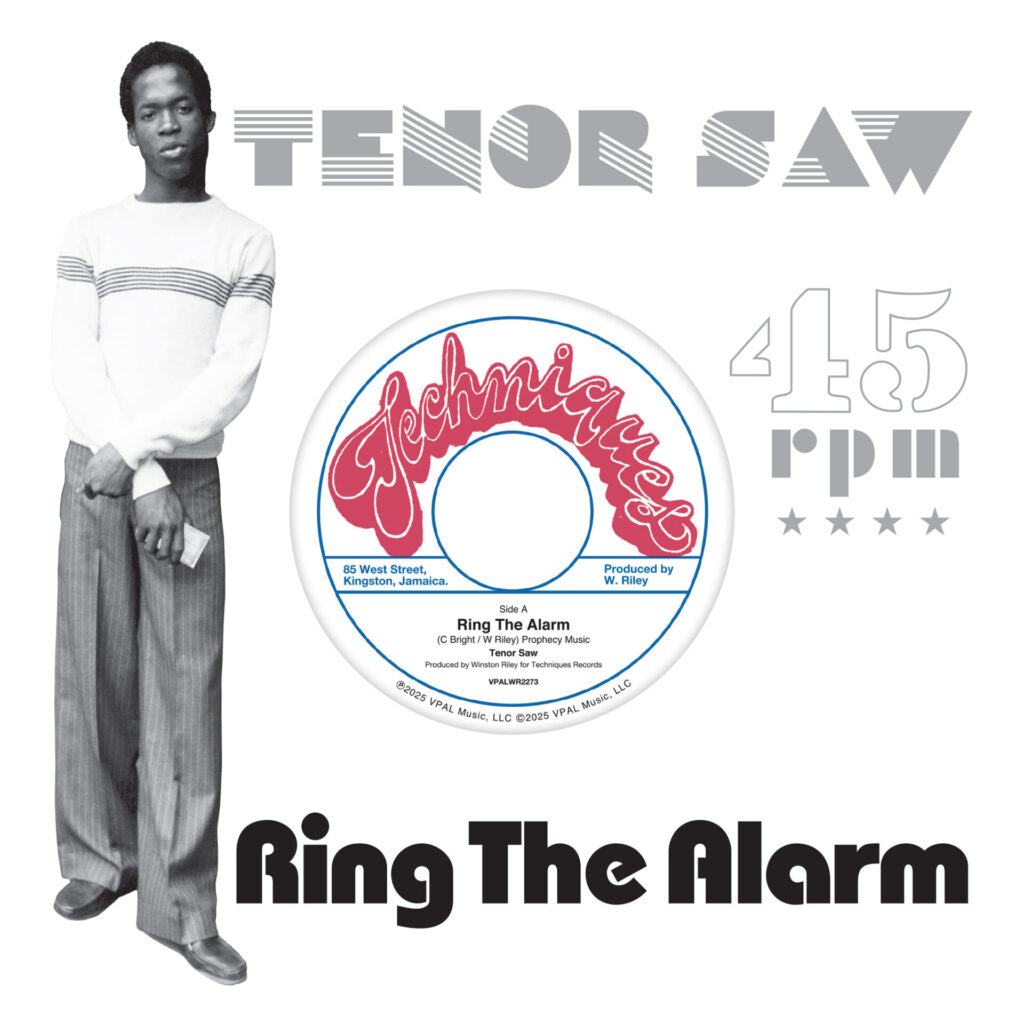1985 was ostensibly the year everything changed for the Jamaican music industry, with the Casio tones of Wayne Smith’s ‘Under Mi Sleng Teng’ seeing every producer reaching for a synth and drum machine, leaving the island’s grass roots musicians in a panic over their diminishing role in this digital dancehall revolution.
That’s only half the story though. While Sleng Teng sparked numerous versions, classic rhythm tracks made by traditional studio bands still dominated the dance, and top of the pile in the summer of 1985 was a funk-infused cut which a young MC known as Tenor Saw rode into the dance with his soundclash anthem ‘Ring The Alarm.’
Unlike the futuristic sound of the Sleng Teng, which Tenor Saw versioned himself earlier that same year, ‘Ring The Alarm’ used a rhythm track which had been doing the rounds for over a decade. The Stalag rhythm, as it is most commonly known, was recorded back in 1973, and usually attributed to organist Ansel Collins whose ‘Stalag 17’ single followed the transatlantic success of ‘Double Barrel’ in 1971, but, as David Rodigan corroborates, it first appeared on an overlooked album of instrumentals by horn heavyweights Tommy McCook and Bobby Ellis called Green Mango. “It’s actually listed as ‘Stag Lack 17’,” Rodigan tells tQ, “Ansell isn’t credited at all.”
Though Collins and the Stalag’s supposed producer Winston Riley would later reap the writing benefits, the drummer on the original session, Carlton “Santa” Davis disputes this, claiming in a 2020 interview for CounterPunch that it was a collaborative effort, and Riley wasn’t even present in the studio. Instead, Riley’s brother Buster oversaw the recording, enlisting Santa and his Soul Syndicate band to lay down a series of instrumentals. George “Fully” Fullwood came up with Stalag’s iconic loping bassline: “That’s all Fully,” Santa insists, while he attributes the unusual drum pattern to his roots as a nyabinghi drummer alongside Ras Michael, recreating the sounds of a Rasta percussion trio, but on his own behind a drum kit.
Fittingly, Stalag’s first vocal cut ‘All Nations Bow’ by the inimitable toaster Big Youth is a stream of consciousness which wouldn’t sound amiss at a grounation; a Rasta gathering where elders “reason” amidst a nyabinghi drum circle. Big Youth would version it again in 75 on the better known ‘Jim Screechy’. Its bizarre succession of slogans caught Mark E. Smith’s attention, as he pondered in a Q interview back in 1990: “What the hell is he going on about in that? Stuff about birth control pills, and John Coltrane was white, and ‘John Coltrane blow so white people blow black people mind every time’. It’s fucking great!”
As the 70s progressed and the dancehall sound began to take shape, early stars of the genre including General Echo, Dillinger and Barrington Levy would lend their lyrics to the Stalag, but most of these recordings came and went without fanfare. Even the now ubiquitous and heavily sampled ‘Bam Bam’ by Sister Nancy remained under radar until Tenor Saw entered Winston Riley’s studio to lay down ‘Ring The Alarm’.
Known as Clive Bright to his mother who took him to church every Sunday, Tenor Saw’s real passion lay in spiritually uplifting songs, having sung in the church choir throughout his youth, but the dancehall came calling and, as he states in his debut 1984 single ‘Roll Call’, he had to be there. Under the tutelage of Sugar Minott, Bright cut his teeth on the Youth Promotion sound system, quickly becoming a vocal sensation with an incomparable singjay style, lighting up dancehalls with buttery smooth torch songs between the gruffer tones of dancehall’s heavyweight MCs.
At a four-way soundclash in the spring of 85, Bright was dismayed to see the crowd going wild for the rival sound systems, and knew he had to defend Youth Promotion. “We have to win!” he exclaimed, recalling the clash in a 1986 interview with Des Mitchell on BBC Birmingham. He continued, “me just go backstage and start tink up a quick idea.” So, with a new lyric in his head as the DJ dropped the needle on the Cuss Cuss rhythm, Bright clutched the mic and delivered his career defining line “four big sounds inna one big lawn, Promotion a’ play, the other three keep calm.” The crowd erupted as the MC continued, “watch the sound man a’ tremble. Watch the sound man afraid!”
He finished writing the song that night, ditching the slower Cuss Cuss in favour of the Stalag rhythm, and he was soon cutting it for Winston Riley who rush-released it on his Techniques label. ‘Ring The Alarm’ blew up dances and lit up the airwaves from Bright’s home town of Kingston, Jamaica to the UK where he toured soon after, and then onto New York and across the States. It quickly became a crossover hit on both sides of the Atlantic, working its way into ragga infused hip hop sets, and slipping into soul selections with its funk-informed rhythm section.
An early non-reggae adopter of the Stalag rhythm, was UK hip hop stalwart DJ Fingers who sampled it using an archaic tape-loop which rolled around chair legs in his label boss “Evil” Eddie Richards’ garage. The result was the debut Sindecut single ‘Can’t Get Enough (Of Who?)’ which dropped in 88 on Richards’ Baad! label, and the rhythm track and ‘Ring The Alarm’ would remain a big draw in Fingers’ sets well into the 90s when junglists were also pilfering Tenor Saw for their Amen-drenched dancefloor bombs.
Stateside, Saw’s song was reappropriated by ragga hip hoppers Fu-Schnickens, and sampled by everyone from Fat Joe to Naughty By Nature. Even Fugazi borrowed the hook for the chorus of ‘Fell, Destroyed’ from their 1995 album Red Medicine, and the rhythm track repeatedly surfaced on anything from bhangra records like Apache Indian’s ‘Move Over India’ to the title track of Faithless’ debut album Reverence, and ragga-rave pioneers Shut Up & Dance would use it wholesale for their “Islands” mix of ‘Beautiful Day’ by surrealist chanteuse Nicolette.
Sadly, Bright never witnessed the reach of his song. While working in the U.S. in August 1988, he was killed in a hit and run on the outskirts of Houston, Texas. What he was doing on a remote stretch of road in the middle of the night remains a mystery, and the culprit has never been caught. Sadder still, he remained a John Doe for weeks after his death until the FBI identified him via fingerprints, but were unable to reach anyone in Jamaica after hurricane Gilbert had torn through the island in September.
The young star received a county burial in Texas with no family or friends present, he was only 21 with a handful of records behind him, but he lives on through an almost endless list of samples, covers, influences and his ever green gift to the world, ‘Ring The Alarm’ which continues to rattle speaker boxers and make sound men and women tremble.
A new 7 inch reissue of ‘Ring The Alarm’ by Tenor Saw is out today via VPAL



